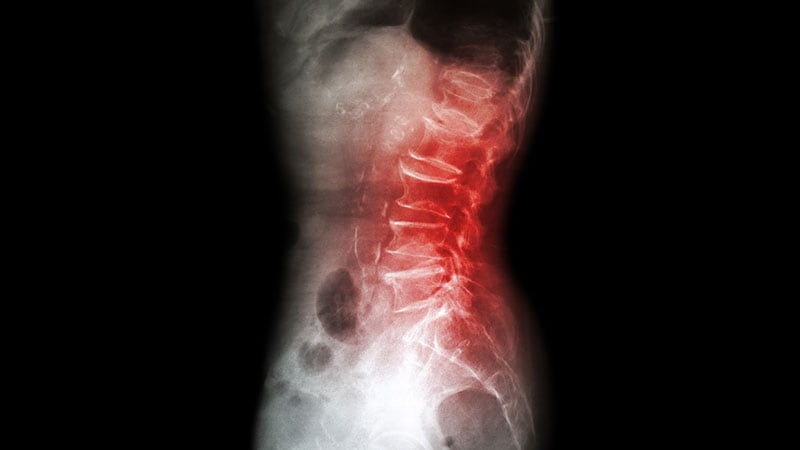Decompression, Fusion Better for Slipped Vertebrae?
LOS ANGELES — New data offers fresh insight into whether to add fusion to decompression treatment for grade 1 degenerative lumbar spondylolisthesis.
Five years after surgical treatment, several outcomes were superior in patients treated with decompression-plus-fusion vs decompression alone, the results suggest.
The findings conflict with previous research questioning whether adding fusion is better, and they aren’t likely to set to rest the debate over the best treatment.
Still, “at a very long-term follow-up, the addition of fusion to decompression was associated with superior leg pain and a higher rate of reaching a minimum clinically important difference in disability and nearly twice the odds of a patient being satisfied,” said neurosurgeon Praveen Mummaneni, MD, MBA, of the University of California San Francisco, in an interview.
Mummaneni presented the retrospective analysis of prospectively collected data on April 22 at the annual meeting of the American Association of Neurological Surgeons (AANS).
According to Mummaneni, degenerative lumbar spondylolisthesis — slipped vertebrae, not slipped disks — affects an estimated 14% of the US population.
“Typically, patients present with back and/or leg pain or a neurologic deficit such as weakness or numbness/tingling,” he said. “Unless there is a significant neurologic deficit, patients are usually trialed on nonoperative therapies first, such as physical therapy, opioid and nonopioid medications, and injections. If these therapies fail to help the patient, then surgery may be considered.”
Surgical approaches — decompression with or without fusion — vary around the world, he said. “Decompression alone has the benefits of faster recovery and lower costs. Decompression with fusion has the benefit of a more durable result but at a higher cost.”
Which approach is better? “Despite multiple randomized controlled trials on the topic, it is still unclear whether the addition of fusion to decompression is necessary. A major issue is that randomized controlled trials employ stringent inclusion criteria that may not be applicable to the real-world patient you are seeing in clinic.”
For the new study, researchers queried the Quality Outcomes Database’s spondylolisthesis registry for outcomes for patients who underwent single-segment surgery to treat Meyerding grade 1 degenerative lumbar spondylolisthesis — either decompression alone (n = 140, 23%) or decompression with fusion (n = 468, 77%).
The registry includes data from 12 high-volume spine centers in the United States. The follow-up rate at 5 years was 73.2%.
Those who underwent decompression with fusion surgery were more likely to have an Oswestry Disability Index score improvement of 12.8, defined as the “minimum clinically important difference” (odds ratio [OR],1.9; 95% CI, 1.2 – 3.1; P = .01), a lower Numeric Rating Scale-Leg Pain score (B = -0.7; 95% CI, -1.3 to -0.1; P = .01), and a higher North American Spine Society satisfaction index score (OR, 1.9; 95% CI, 1.2 – 3.0; P = .01).
“The leg pain finding was somewhat surprising given that both decompression with fusion and decompression alone are thought to treat leg pain with similar effectiveness,” Mummaneni said. “However, our data suggests that the added durability afforded by fusion may result in better leg pain at 5 years because the fused levels do not experience re-stenosis.”
There were no statistically significant differences between the groups for the Numeric Rating Scale-Back Pain score (P = .36), Oswestry Disability Index score (P = .18), and EQ-5D (P = .27).
The 5-year cumulative reoperation rates were not statistically different either: The rate for decompression alone was 14.3% vs 10.7% for decompression with fusion (P = .24).
As for side effects, “the rates of re-stenosis and reoperation are typically higher following decompression alone. Given that a decompression with fusion involves instrumentation, there can be implant-related complications following fusion.”
He added that “following decompression with fusion, successful surgery will depend on the patient’s bones healing together. If the bones do not fuse, they may be at risk of instrumentation failure and pseudarthrosis. Also, you may stiffen a spinal segment with a fusion, and adjacent segments may receive more stress. This can lead to adjacent segment degeneration and possible need for reoperation in a subset of those patients.”
In a commentary provided at AANS 2023 in conjunction with Mummaneni’s presentation, Cleveland Clinic neurosurgeon Michael P. Steinmetz, MD, praised the study. But it’s not randomized, he pointed out, noting there’s likely selection bias as the sizes of the two cohorts are vastly different, with many more patients getting decompression and fusion. “And we can question what the clinical meaningful differences between those outcomes are,” he added.
In an interview, neurosurgeon Ivar Austevoll, MD, PhD, of Haukeland University Hospital in Bergen, Norway, said the findings conflict with those of previous small, randomized, controlled trials. Austevoll, who wasn’t involved with this research, is lead author of a 2021 New England Journal of Medicine study that found 2-year outcomes for the two surgical strategies were similar.
He also echoed Steinmetz by noting that surgery strategies differ between patients: “Commonly, the oldest and most fragile patients are not being fused, while younger and more healthy patients are offered fusion.”
For now, Austevoll said, it seems “reasonable” to perform decompression with fusion, “but more evidence is needed regarding long-term results.” According to him, his team is now analyzing 5-year results from his study and long-term results from Norway’s national spine registry.
The study was funded by the Neurosurgery Research and Education Foundation, the NeuroPoint Alliance, and the AANS/Congress of Neurological Surgeons Joint Section on Disorders of the Spine and Peripheral Nerves. Mummaneni reported multiple disclosures, including grant/research support from the Alan and Jacqueline Stuart Spine Outcomes Center, AO Spine, International Spine Study Group, and the National Institutes of Health, among others, and relationships including stock ownership (Spinicity/ISD), consultant work, and royalties. Steinmetz and Austevoll report no relevant financial relationships.
American Association of Neurological Surgeons (AANS). Presented April 22, 2023.
For more Medscape Neurology news, join us on Facebook and Twitter
Source: Read Full Article
